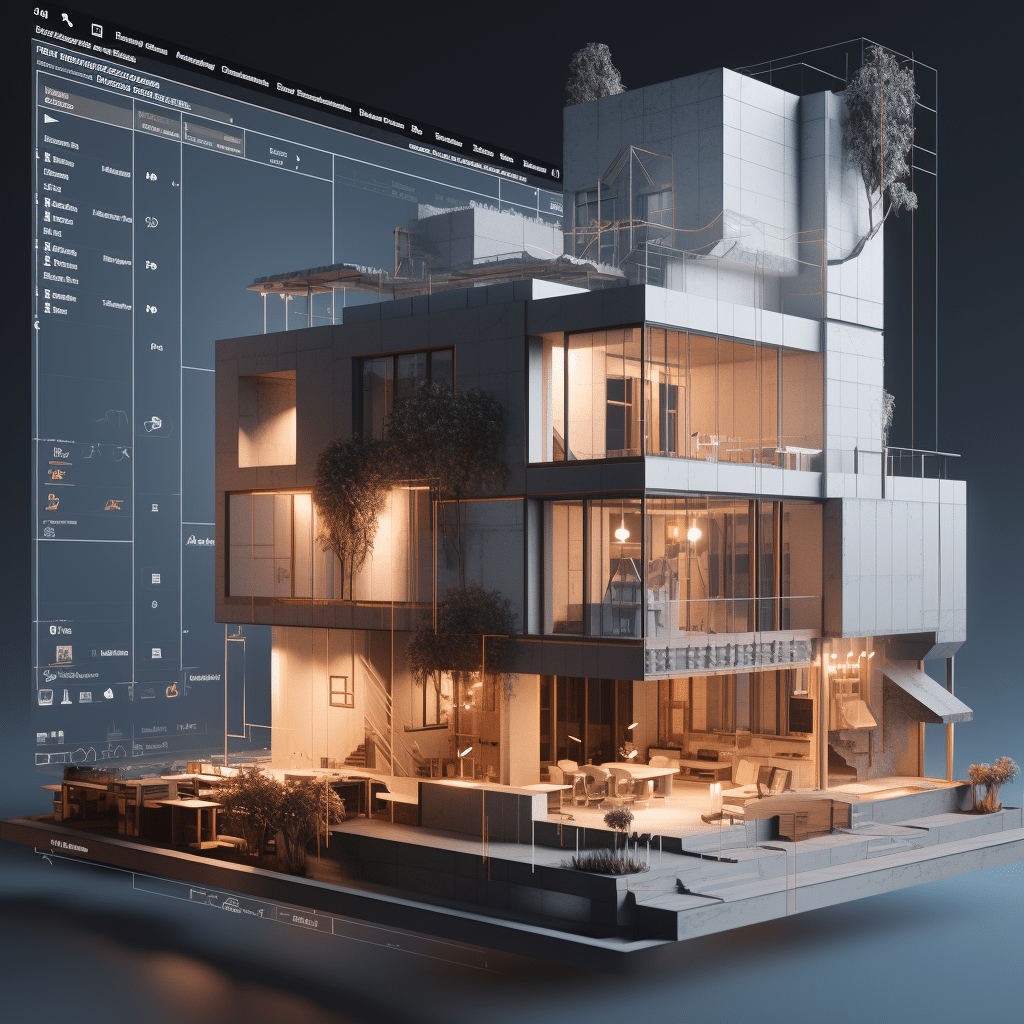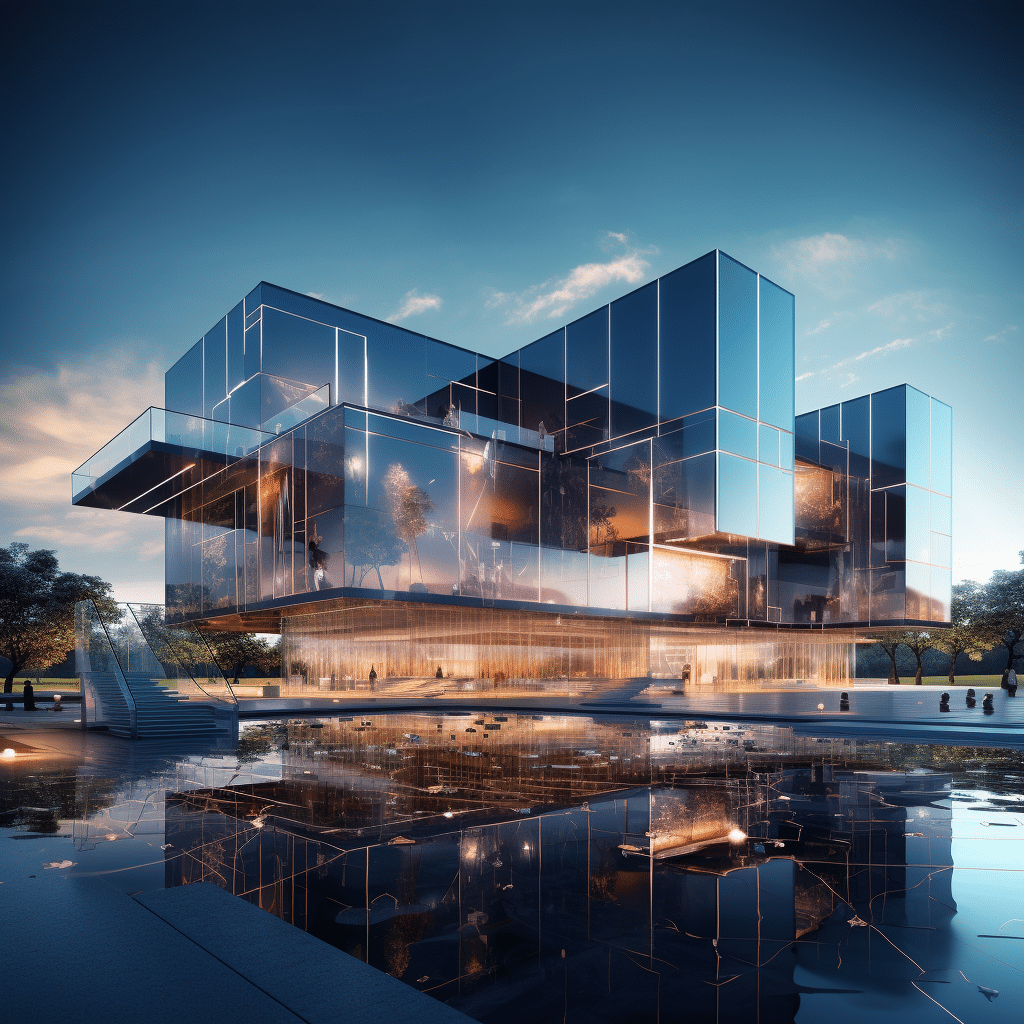Revolutionizing Architectural Design with Creative AI Solutions
AI is revolutionizing architectural design by giving architects new tools to improve creativity and efficiency. AI can transform design processes and create smarter buildings that meet society’s changing needs.
Key Takeaways:
- AI tools are revolutionizing architectural design by enhancing creativity and efficiency.
- Midjourney generates photorealistic images to illustrate conceptual thinking in architectural design.
- Adobe Firefly streamlines workflow and generates creative content for architects.
- Maket.ai generates design alternatives tailored to client-specific requirements in architectural design.
- ArkDesign.ai optimizes building designs while ensuring compliance with local regulations.
The Benefits of AI in Architectural Design

AI in architectural design offers numerous benefits, enhancing architects’ creativity, efficiency, and problem-solving capabilities. With the help of AI tools, architects can revolutionize the design process and create smarter and more efficient buildings.
One of the key advantages of using AI in architectural design is improved creativity. AI-powered tools like Midjourney generate photorealistic images based on written prompts, helping architects illustrate their conceptual thinking. This allows for better visualization of design ideas and helps architects communicate their vision to clients and other stakeholders.
AI in architectural design boosts efficiency. Adobe Firefly automates repetitive tasks and generates creative content. This saves architects time and effort, allowing them to focus on more complex design challenges. Also, AI tools like Maket.ai can generate design alternatives tailored to client needs, speeding up the design process and giving clients more options.
Furthermore, AI in architectural design improves problem-solving capabilities. Tools such as ArkDesign.ai analyze building designs and optimize them while ensuring compliance with local regulations. This helps architects overcome design constraints and create sustainable and functional buildings. Similarly, Sidewalk Labs uses machine learning and sensor technologies to manage urban congestion, addressing one of the major challenges in architectural design.
| AI Tool | Benefits |
|---|---|
| Midjourney | Enhances conceptual thinking and visualization |
| Adobe Firefly | Streamlines workflow and generates creative content |
| Maket.ai | Generates customized design alternatives |
| ArkDesign.ai | Optimizes designs while ensuring compliance with regulations |
| Sidewalk Labs | Manages urban congestion using machine learning and sensor technologies |
AI tools boost architects’ creativity, efficiency, and problem-solving. These tools allow architects to design stunning, functional, sustainable, and compliant buildings. AI in architectural design will advance with new tools and technologies.
AI Tools for Architectural Design
Midjourney, Adobe Firefly, Maket.ai, ARCHITEChTURES, ArkDesign.ai, Sidewalk Labs, Kaedim, Sloyd.AI, and Luma.ai are AI tools for architectural design. These tools are transforming architects’ creativity, efficiency, and problem-solving.
Midjourney, an AI application, creates photorealistic visuals from written questions that demonstrate conceptual thinking. This application helps architects visualize their ideas realistically, making design communication and refinement easier.
Adobe Firefly improves workflow and creates innovative content. Firefly lets architects communicate, share files, and iterate designs seamlessly. The tool offers visual assets and templates to improve creativity.
Maket.ai develops client-specific design options using AI. It speeds up design exploration for architects. Maket.ai gives architects options based on customer preferences and limits, saving time and effort in the design process.
| AI Tool | Description |
|---|---|
| Midjourney | Generates photorealistic images to illustrate conceptual thinking in architectural design. |
| Adobe Firefly | Streamlines workflow and generates creative content in architectural design. |
| Maket.ai | Generates design alternatives tailored to client-specific requirements in architectural design. |
| ARCHITEChTURES | An AI-powered tool for residential planning that analyzes site conditions, climate dynamics, and client aspirations. |
| ArkDesign.ai | Optimizes building designs while ensuring compliance with local regulations in architectural design. |
| Sidewalk Labs | Uses machine learning and sensor technologies to manage urban congestion in architectural design. |
| Kaedim & Sloyd.AI | AI-powered tools for 3D modeling that enable architects to explore various design concepts and create accurate representations. |
| Luma.ai | A tool for 3D scanning and modeling that generates realistic models from photographs for renovation projects. |
These AI tools are transforming the architectural design process and opening up new possibilities for architects. From enhancing conceptual thinking to streamlining workflow, optimizing designs, and managing urban congestion, AI is reshaping the way architects work, making it easier to create innovative and sustainable designs that meet client expectations.
Midjourney: Enhancing Conceptual Thinking
Midjourney is an AI application that generates photorealistic graphics to assist architects see and improve their design concepts. Using written prompts, architects can create magnificent graphic representations of their ideas with incredible detail and realism.
Using this AI tool, architects may explore design options and better interact with clients and stakeholders. With Midjourney, architects can create captivating graphics that capture the essence and emotion of their designs, helping people understand and appreciate them.
Midjourney’s photorealistic visuals alter architecture design creative thinking. A few basic prompts allow architects to experiment with materials, lighting, and spatial configurations. This AI technology helps architects envision and develop their ideas, enabling them to make educated decisions that lead to exceptional architectural designs.
| Benefits of Midjourney: |
|---|
| 1. Enhances conceptual thinking through photorealistic images |
| 2. Facilitates effective communication of design concepts to clients and stakeholders |
| 3. Allows architects to explore design variations and experiment with different elements |
| 4. Enhances creativity and enables informed decision-making |
Midjourney is a game-changing AI tool for architects that improves conceptual thinking in architectural design. Its photorealistic graphics allow architects to visualize their plans and better explain their ideas. Midjourney and other AI tools revolutionize architectural design, creating unlimited options and driving innovation.
Streamlining Workflow with Adobe Firefly
Sidewalk Labs is using AI, ML, and sensors to change how architects plan cities. This AI solution manages urban congestion to increase mobility, reduce traffic, and create more sustainable and habitable communities.
Another advantage of using Adobe Firefly is its ability to generate creative content. The AI-powered tool can analyze vast amounts of data and generate design options based on user-defined parameters. This not only saves time but also sparks new ideas and possibilities, pushing the boundaries of architectural design.
Moreover, Adobe Firefly offers seamless integration with other design software, making collaboration and project management more efficient. Architects can easily share their work with colleagues, clients, and stakeholders, fostering effective communication and ensuring everyone is on the same page.
| Benefits of Adobe Firefly: |
|---|
| 1. Streamlines workflow and automates repetitive tasks. |
| 2. Generates creative content based on user-defined parameters. |
| 3. Enhances collaboration and project management through seamless integration. |
Customized Design Alternatives with Maket.ai
Maket.ai uses AI to provide bespoke architectural design options based on customer needs and preferences. Maket.ai is changing how architects design using its powerful algorithms and machine intelligence.
Maket.ai swiftly analyzes and understands client demands. By entering budget, style, and functional requirements, architects can create design options that meet the client’s needs. This saves time in the initial design process and ensures the final design matches the client’s vision.
Maket.ai goes beyond offering alternate designs. It gives architects insights and data-driven advice. Maket.ai analyzes a massive library of architectural styles, materials, and construction methods to offer efficient, sustainable, and cost-effective design options.
| Feature | Benefits |
|---|---|
| Customized Design Alternatives | Meet client-specific requirements and preferences |
| Data-Driven Recommendations | Optimize efficiency, sustainability, and cost-effectiveness |
| Quick Analysis | Save time in the design phase |
Maket.ai also integrates seamlessly with other architectural design software and platforms, making it easy for architects to use its design alternatives. The design process, from concept to completion, is more efficient.
As architects embrace artificial intelligence, Maket.ai is a powerful tool for creating innovative and personalized designs. AI can open new doors for architects and help them exceed client expectations.
Optimizing Designs with ArkDesign.ai
ArkDesign.ai is an AI tool that optimizes building designs, balancing creativity with compliance with local regulations in architectural design. It offers architects a seamless way to design structures that not only push the boundaries of creativity but also adhere to the necessary regulations and standards.
With ArkDesign.ai, architects can streamline their design process by leveraging advanced algorithms and machine learning. The tool takes into account various factors such as site conditions, climate dynamics, and client aspirations to generate designs that are not only aesthetically pleasing but also functionally efficient.
One of the key advantages of using ArkDesign.ai is its ability to consider local regulations and building codes. By integrating this knowledge into its algorithms, the tool ensures that architects can create designs that meet the necessary legal requirements while still pushing the boundaries of design innovation.
Whether it’s analyzing setback requirements, maximum building heights, or even material restrictions, ArkDesign.ai can optimize building designs to comply with all relevant regulations. This ensures that architects can create structures that are not only visually stunning but also practical and safe.
| Benefits of ArkDesign.ai: |
|---|
| 1. Creativity: ArkDesign.ai enables architects to explore innovative design ideas while ensuring compliance with regulations. |
| 2. Efficiency: By automating the design process and considering local regulations, the tool saves architects time and effort. |
| 3. Compliance: ArkDesign.ai guarantees that building designs meet the necessary legal requirements and standards. |
Overall, ArkDesign.ai is revolutionizing the architectural design landscape by providing architects with a powerful and efficient tool for optimizing their designs. With its ability to balance creativity and compliance, this AI tool empowers architects to create buildings that are not only visually impressive but also meet the necessary regulations and standards.
Managing Urban Congestion with Sidewalk Labs
Sidewalk Labs is an AI maverick that leverages machine learning and sensor technologies to tackle the challenge of urban congestion in architectural design. With an innovative approach, this AI tool analyzes real-time data from sensors located throughout cities, such as traffic flow, population density, and transportation patterns, to develop smart solutions that optimize urban environments.
By harnessing the power of machine learning algorithms, Sidewalk Labs can predict traffic congestion hotspots and propose intelligent strategies to alleviate traffic flow. This includes optimizing transportation routes, implementing dynamic traffic signal control systems, and promoting alternative modes of transportation, such as bike sharing or ride-sharing platforms.
The use of sensor technologies further enhances Sidewalk Labs’ capabilities in managing urban congestion. These sensors can collect data on various parameters, including air quality, noise levels, and pedestrian movement, allowing architects to make data-driven decisions when designing urban spaces. With this information, Sidewalk Labs can identify areas that may require additional infrastructure or redesign to improve mobility and reduce congestion.
Key Features of Sidewalk Labs:
- Utilizes machine learning algorithms to predict and manage traffic congestion
- Analyzes real-time data from sensors to optimize urban environments
- Proposes smart solutions for transportation routes and traffic signal control
- Promotes alternative modes of transportation, such as bike sharing or ride-sharing platforms
- Collects data on air quality, noise levels, and pedestrian movement to inform the design process
Sidewalk Labs is using AI, ML, and sensors to change how architects plan cities. This AI solution manages urban congestion to increase mobility, reduce traffic, and create more sustainable and habitable communities.
| Key Features | Benefits |
|---|---|
| Utilizes machine learning algorithms | Predicts and manages traffic congestion |
| Analyzes real-time data from sensors | Optimizes urban environments |
| Proposes smart solutions for transportation routes | Improves traffic flow |
| Promotes alternative modes of transportation | Reduces reliance on private vehicles |
| Collects data on air quality, noise levels, and pedestrian movement | Informs design process for more sustainable urban spaces |
Exploring Design Concepts with Kaedim, Sloyd.AI, and Luma.ai
Kaedim, Sloyd.AI, and Luma.ai help architects build precise 3D models of design concepts. These tools make architects’ design conceptualization and visualization more efficient and effective.
Kaedim, an AI tool, streamlines 3D modeling for architects. It generates realistic models using complex algorithms and machine learning, allowing architects to swiftly test design ideas. Kaedim allows architects to experiment with styles, materials, and structural aspects to satisfy client needs.
Sloyd.Another AI-powered tool lets architects generate amazing 3D models. Architectural designs can be accurately modeled with detailed features and textures using its straightforward interface and powerful capabilities. Collaboration capabilities on Sloyd.AI let architects share designs with colleagues and clients for feedback.
Luma.ai is vital for remodeling architects. 3D scanning and modeling gather precise information about existing structures and areas. This data lets architects create realistic models to visualize how their design improvements will fit into the environment. Luma.ai helps architects make informed renovation decisions to match their designs to the existing architecture.
| AI Tool | Functionality |
|---|---|
| Kaedim | Seamless workflow for 3D modeling |
| Sloyd.AI | Powerful capabilities for generating accurate representations |
| Luma.ai | 3D scanning and modeling technology for renovation projects |
These AI tools have revolutionized the architectural design process, empowering architects to explore and present their design concepts with precision and creativity. With Kaedim, Sloyd.AI, and Luma.ai, architects can push the boundaries of their imagination and deliver exceptional designs that meet the unique needs of their clients.
The Future of AI in Architectural Design

AI will continue to transform architectural design and change how architects develop and design structures. AI tools in architectural design have shown promise in improving architects’ creativity, efficiency, and problem-solving. AI-powered tools like Midjourney allow architects to create lifelike conceptual renderings. Architekten can better explain their design ideas and explore numerous options through graphic representation.
AI solutions like Adobe Firefly automate monotonous operations and generate innovative material, streamlining architectural design productivity. This lets architects focus on conception and higher-level decision-making, creating more creative and deliberate designs.
AI in architectural design could improve customisation and optimization. AI solutions like Maket.ai allow architects to develop client-specific design alternatives, making architectural design more personalized. Tools like ArkDesign.ai optimize construction designs while conforming to local norms, reducing disputes and maximizing design efficiency. AI will continue to manage urban congestion in the future.
AI-powered 3D modeling tools like Kaedim, Sloyd.AI, and Luma.ai will help architects explore many design ideas and build accurate representations. These technologies help architects visualize and implement their ideas more accurately and efficiently for residential planning and restoration projects. Architectural design will evolve into smarter, more efficient buildings that effortlessly mix beauty and usefulness as architects embrace AI.
FAQ
Q: How can artificial intelligence be used in architectural design?
A: Artificial intelligence can be used in architectural design to enhance creativity, efficiency, and problem-solving abilities. It revolutionizes the design process and leads to smarter buildings.
Q: What are the benefits of using artificial intelligence in architectural design?
A: The benefits of using artificial intelligence in architectural design include improved creativity, efficiency, and problem-solving abilities.
Q: What are some AI tools available for architectural design?
A: Some AI tools available for architectural design include Midjourney, Adobe Firefly, Maket.ai, ARCHITEChTURES, ArkDesign.ai, Sidewalk Labs, Kaedim, Sloyd.AI, and Luma.ai.
Q: How does Midjourney enhance conceptual thinking in architectural design?
A: Midjourney is an AI tool that generates photorealistic images based on written prompts to help illustrate conceptual thinking in architectural design.
Q: How does Adobe Firefly streamline workflow in architectural design?
A: Adobe Firefly is an AI tool that streamlines workflow and generates creative content in architectural design.
Q: How can Maket.ai generate customized design alternatives in architectural design?
A: Maket.ai is an AI tool that generates design alternatives tailored to client-specific requirements in architectural design.
Q: How does ArkDesign.ai optimize building designs in architectural design?
A: ArkDesign.ai is an AI tool that optimizes building designs while ensuring compliance with local regulations in architectural design.
Q: How can Sidewalk Labs manage urban congestion in architectural design?
A: Sidewalk Labs is an AI maverick that uses machine learning and sensor technologies to manage urban congestion in architectural design.
Q: How do Kaedim, Sloyd.AI, and Luma.ai enable architects to explore design concepts in architectural design?
A: Kaedim, Sloyd.AI, and Luma.ai are AI tools for 3D modeling that allow architects to explore various design concepts and create accurate representations in architectural design.
Q: What is the future of artificial intelligence in architectural design?
A: The future of artificial intelligence in architectural design holds new possibilities and a transformative impact on the industry.








